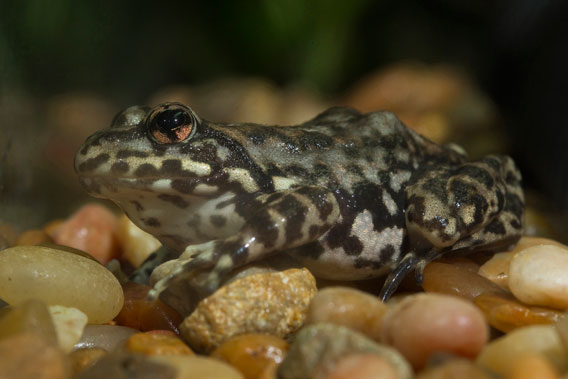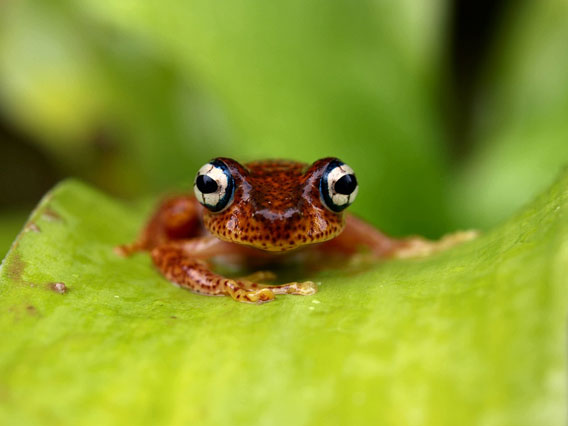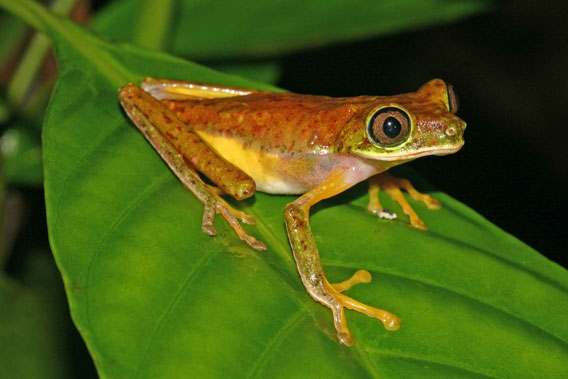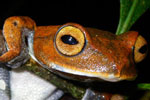
The San Diego Zoo Institute for Conservation Research in California, USA has been a partner in the recovery of the Southern California population of Mountain Yellow-legged Frogs, Rana muscosa, over the past five years and continues to make progress in captive breeding and reintroduction efforts of this endangered species. Photo: Ken Bohn, San Diego Zoo.
The NGO Amphibian Ark is asking frog-lovers to visit their local zoos on up-coming leap day, February 29th. Dubbed, Leaping Ahead of Extinction, the program includes 58 zoos and other amphibian breeding facilities in seventeen countries that have captive breeding populations of endangered amphibians.
“For every one species of bird or mammal in trouble, there are two to three amphibian species on the brink of extinction,” said Kevin Zippel, Amphibian Ark Program Director in a press release. “The current amphibian extinction crisis is reminiscent of the disappearance of the dinosaurs, making it one of the greatest conservation challenges in the history of humanity.”
Despite the crisis, the events hope to highlight the positive captive breeding efforts that are keeping some amphibians away from the edge of extinction.
Particularly sensitive to environmental degradation amphibians are imperiled by deforestation, wetland loss, pollution, overexploitation, the pet trade, invasive species, and climate change. In addition, a deadly fungal disease called chytridiomycosis has wiped out whole species even in pristine environments. Already 165 amphibians have gone extinct, while another 130 are feared to be extinct.
Amphibian Ark—a joint effort of the World Association of Zoos and Aquariums, the IUCN/SSC Conservation Breeding Specialist Group, and the IUCN/SSC Amphibian Specialist Group—is currently targeting 500 amphibians for captive breeding which they fear will not survive otherwise.

The area around Andasibe in east‐central Madagascar supports more than 100 species of frogs. Mitsinjo, a community‐run conservation organization based in Andasibe, has recognized the importance of their uniquely rich amphibian fauna by developing a captive breeding and husbandry research facility at Analamazaotra Special Reserve for species such as Boophis pyrrhus. Photo: Devin Edmonds.

The Lemur Leaf Frog, Agalychnis lemur, remains one of the world’s most Critically Endangered amphibians. The live specimens that are maintained at The Manchester Museum in the UK are from one of the last remaining populations in Costa Rica, and the captive breeding program there was first started in 2001. Over the years, young animals bred at the Museum have been distributed to zoos around the world, including Bristol Zoo in England, the Vancouver Aquarium in Canada, and the Atlanta Botanical Gardens in the US. Photo: Matt Wilson/Manchester Museum.
Related articles
Vampire and bird frogs: discovering new amphibians in Southeast Asia’s threatened forests

(02/06/2012) In 2009 researchers discovered 19,232 species new to science, most of these were plants and insects, but 148 were amphibians. Even as amphibians face unprecedented challenges—habitat loss, pollution, overharvesting, climate change, and a lethal disease called chytridiomycosis that has pushed a number of species to extinction—new amphibians are still being uncovered at surprising rates. One of the major hotspots for finding new amphibians is the dwindling tropical forests of Southeast Asia.
(01/03/2012) The chytrid fungus, which is responsible for the collapse of numerous amphibian populations as well as the extinction of entire species, has been located for the first time in India, according to a paper in Herpetological Review. Researchers took swabs of frog in the genus Indirana in the Western Ghats and found the killer fungus known as chytridiomycosis.
Photos: two new paper clip-sized frogs discovered in Vietnamese mountains

(12/07/2011) Researchers have discovered two new frog species living in the montane tropical forests of Vietnam. Known as moss frogs, these small amphibians employ camouflage as one way to keep predators at bay, in some cases resembling the moss that gives them their name.